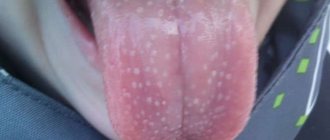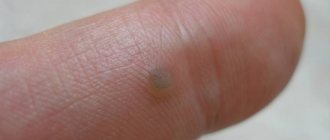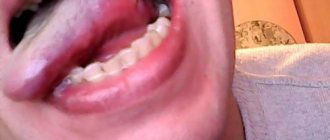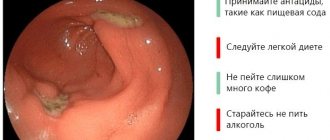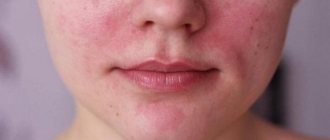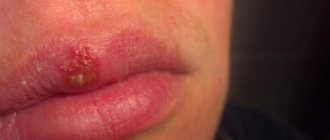A white ball has formed on a child’s tongue - what could it be?
by Vlad · Published 05/15/2018 · Updated 05/07/2019
A ball on a child’s tongue is a relatively rare occurrence. More precisely, it is rarely diagnosed: such a neoplasm can exist for a long time without causing discomfort, after which it goes away on its own and goes unnoticed.
But if you detect any lump on the tongue, you should consult a doctor - this symptom can be either a manifestation of physiological processes or indicate the development of pathology.
Causes and associated symptoms
Balls on a child’s tongue can form for several reasons. Most often, the following diseases and conditions become the source of the problem:
| Improper feeding | A ball on the tip of a child’s tongue is most often diagnosed in children in the first six months of life who are exclusively breastfed or formula-fed. The reason, as a rule, is detected immediately: improper attachment of the baby to the breast or incorrect choice of feeding accessories. In this case, the ball is a kind of growth or callus - a compaction on the surface of the tongue, formed due to constant pressure and/or friction applied to the same area. Usually this symptom is accompanied by characteristic signs of dyspepsia - bloating, frequent or profuse regurgitation, intestinal colic. These symptoms indicate that the child has swallowed a large amount of air, which is caused by improper attachment to the breast, inappropriate nipple size for feeding, etc. It is typical that callus appears only after a few months, and the ball on the tongue of a newborn initially appears as a blister (dropsy) - soft a thin-walled formation filled with a clear liquid. |
| Hematoma | A dense but mobile ball of crimson or black-violet color, which appears without any previous symptoms, in most cases turns out to be a hematoma. It can be located in any part of the tongue that is in one way or another in contact with the surface of the teeth - injury usually occurs when the tongue is sharply bitten. Less commonly, this formation is observed at the base of the tongue - in such cases, it is most likely due to injury from a large and/or hard piece of food. |
| Scar changes | This condition most often appears as a white ball under the child's tongue or another shaped formation (fissure). It is dense, painless, stands out sharply against the background of other areas of the mucosa and does not increase in size over time. The scar is formed as a result of frequent or significant injury to the hyoid frenulum, a fold of mucous membrane that connects the floor of the mouth and the tongue. The injury is often observed in children with frenulum insertion abnormalities and frequent coughing spells. In the first case, the mucous membrane is torn due to insufficient length and/or elasticity of the frenulum, and in the second - due to strong protrusion of the tongue forward during a strong cough. |
| Struma (cyst) | This is a congenital and fairly rare condition in which a piece of thyroid tissue develops at the base of the tongue. Such balls on the root of a child’s tongue require mandatory consultation with a doctor, as they tend to increase in size under unfavorable circumstances, which becomes an obstacle to the full functioning of the respiratory and digestive systems. |
Malocclusion
Blood blisters can be caused by an incorrect bite or improperly fitted orthopedic devices (such as braces or dentures). As a result of constant mechanical damage to the mucous membrane, bursting blisters may appear on the gums, tongue or cheeks, causing severe pain and bleeding.
Typically, such phenomena occur at the initial stages of using such structures. After contacting a specialist and eliminating the defect in the orthopedic device, such phenomena disappear.
Possible complications
The tongue is a very important organ, even though it may look different. It is involved in the primary mechanical processing of food (helps to grind it and move it into the esophagus), is responsible for articulation and the quality of diction, promotes proper breathing, removal of foreign bodies from the upper respiratory tract and prevents food from entering the trachea.
Accordingly, any changes in this organ can cause more severe disorders that are not limited to the oral cavity. These include breathing disorders, frequent diseases of the ENT organs, digestive dysfunction and many other complications.
Candidal stomatitis
Many are accustomed to thinking that stomatitis caused by the Candida fungus virus makes itself felt only through ulcers and rashes that appear on the gums and palate. But in fact, its main symptom is a dense whitish or grayish coating of curd consistency on the tongue. If you try to remove such plaque, you will find blisters underneath that itch, hurt, and bleed. As a rule, small blisters are found around the perimeter of the tongue.
The photo shows candidal stomatitis
Often the disease is provoked not only by weakened immunity, dysbiosis and long-term use of antibiotics, but also by the presence of advanced dental pathologies and lack of proper oral hygiene.
Treatment methods
Treatment of balls on the tongue directly depends on the reasons for which this symptom developed:
| Causes | Treatment methods |
| Improper feeding | First of all, it is necessary to replace feeding accessories with ones that are suitable for the child’s age or teach the mother how to properly attach the child to the breast. In the intervals between feedings, it is recommended to treat dropsy with antiseptic solutions selected according to the age of the child. When a calloused area is formed, local anti-inflammatory therapy and the use of agents that improve regeneration processes (Cholisal, Solcoseryl, Pansoral, Kalgel, etc.) can be carried out. |
| Hematoma | As a rule, no special therapy is required - it is enough to monitor the healing of the injured area and protect it from the irritating effects of sour, salty, hot, coarse and hard foods. If a child is prone to infectious diseases, it may be recommended to rinse the mouth with a solution of Chlorhexidine, Rotocan, Tantum Verde (the drug is selected according to the child’s age). |
| Scar changes | If the scar grows significantly, which causes discomfort, problems with articulation, etc., it is surgically removed. It is also important to eliminate the root cause of this condition - correct the position or length of the hyoid frenulum, undergo a course of treatment for diseases of the ENT organs that cause hacking cough, etc. |
| Struma (cyst) | Treatment is prescribed after consultation with a geneticist and endocrinologist. Therapy is selected taking into account the characteristics of the clinical case. |
Prevention
Not all conditions and diseases can be prevented. But to prevent traumatic and scar changes, there are simple and effective methods:
- Timely treatment of structural disorders of the dental system and oral cavity (reconstruction of broken or caries-damaged teeth with sharp edges, frenuloplasty, etc.).
- Organizing proper nutrition (the child’s food should not be hot or cold, and until he learns to chew food thoroughly, it should be crushed).
- Choosing the right feeding accessories and their regular antiseptic treatment.
If you notice such symptoms in a child, be sure to contact your pediatric dentist or any other doctor.
Causes
The mucous membrane of the mouth is a fairly resistant surface to various influences. But when it is injured, or an imbalance occurs in the body due to diseases, an inflammatory process can occur, which leads to the formation of a bubble under the tongue. Other problems can also be the main causes of pathology.
Injury
Mechanical disruption of the salivary duct of the gland leads to the thickening of the connective tissue and this causes the appearance of a ball under the tongue. A toothbrush with rough bristles, fish bones, a chipped tooth, a toothpick, breaking the cover, activates inflammation.
Antihygiene
In this case, a blister under the tongue appears due to failure to observe basic oral hygiene. This could be someone else's toothbrush, spoons, forks, or rare care.
Syphilis
This disease tends to negatively affect the condition of the mucous membranes, causing tumors.
Complications after illness
The bubble occurs after suffering from mumps, sore throat, or influenza. The salivary gland swells, and against the background of this, stagnation of secretion occurs.
Infection
Microtraumas that occur on the mucous membrane can be infected with bacteria and microbes, fungus, which leads to the formation of an inflamed blister.
Oncology
The disease provokes the formation of a tumor that puts pressure on the area under the tongue. In the early stages, the disease goes unnoticed, but over time, saliva production decreases and a transparent cyst appears, which eventually grows to 3 centimeters.
Food and medicine
A blood ball under the tongue appears for the following reasons:
- Injury that occurs from biting the mucous membrane while eating.
- Chemical burn.
- Hot food or drink.
- Medicines.
- Spicy and salty foods.
- Blocking the duct with a stone.
Ranula
A ball under the tongue can cause ranula. It appears against the background of an inflammatory process in the sublingual area or when the normal functioning of the salivary gland is disrupted. Initially, the disease manifests itself as a bluish discoloration in the oral cavity. After which a bubble appears, which after some time bursts and is observed again in the same place.
On this topic
Find out what to do if a pimple on your tongue hurts
- Olga Alexandrovna Novikova
- August 30, 2020
Experts still cannot establish the causes of this disease. Some believe that the pathology arose against the background of an inflammatory process, while others suggest that these are epithelial inclusions of germinal origin. That is, the tumor is a cystic epithelial neoplasm.
The pathology develops against the background of blockage of the salivary gland duct and does not allow saliva to be released into the oral area. This leads to the fact that it accumulates in the gland, which increases to 5 cm in diameter. After which the formation is ruptured on its own or opened by a surgeon using a scalpel.
The ranula looks like a bubble with a clear liquid, which does not cause pain, but brings discomfort to the patient in the oral mucosa.
Aphthous stomatitis
Aphthous stomatitis is also one of the causes of a bubble under the tongue. This is an inflammatory process that occurs in the area of the oral mucosa, which is manifested by the appearance of aphthae. Aphthous stomatitis is a common disease and can be treated by a dentist. The main factors in the occurrence of pathology are:
- disruptions in the functioning of the immune system;
- viruses;
- hormonal fluctuations;
- heredity;
- allergic reactions;
- diseases of the digestive tract;
- diseases of the gums and teeth;
- injuries;
- lack of nutrition;
- hypovitaminosis;
- stress, depression, nervous tension;
- accompanying illnesses;
- violation of personal hygiene rules.
Aphthous stomatitis is very common in young children, especially during teething. At this point, you should definitely consult a doctor.
Features of the disease
At first, blisters on the tongue do not bother a person at all, but over time they grow, and the infected cavity is filled with new fluid - creating a favorable environment for the development of a secondary infection. What is the hidden danger of a blister on the cheek or a rash closer to the throat? A minor detail can cause a serious chronic disease. Before self-medicating or leaving the bubble unattended, it is recommended to visit a doctor for a detailed consultation.
Timely treatment will not only save extra time, but also protect your health from irreversible consequences.
Inflammation of the blister - ulcerative necrotizing glossitis
Symptoms
Symptoms of the pathology depend on the reason for which it arose.
With injuries in the tongue area, blisters may appear not only under the tongue, but also on the side. It is mainly pink in color or engorged with blood, which is visible to the naked eye.
If any blood manifestations are absent, then this indicates the superficial nature of the pathology; most often, such a bubble goes away on its own and does not cause noticeable harm to health. When a blood clot appears, the hematoma is very deep and can become a breeding ground for pathogenic bacteria, most often this leads to an inflammatory process.
On this topic
How to quickly get rid of a pimple on the gum
- Maria Konstantinovna Tevs
- July 29, 2020
A small bubble that has popped up may be the cause of vitamin deficiency. In this case, the patient feels almost no discomfort. Such manifestations disappear within a few days. To prevent the bubble from appearing again, you need to reconsider your diet and enrich your diet with vegetables, fruits, meat and dairy products. It is also recommended to undergo a course of treatment with vitamins.
If bloody inclusions are noticed in the bubble, then this is most likely a rune, which can only be removed through surgery.
What to do if there are any?
If any strange formations appear on the tongue, the most reasonable solution would be to show them to the doctor. If there is a suspicion that the symptoms are associated with throat diseases, you need to contact an otolaryngologist - ENT, and in other cases you should consult a dentist or therapist. The doctor will be able to adequately assess the situation and take the necessary actions to make the correct diagnosis:
- Conduct a blood test.
- Scrap the tongue and conduct a microscopic or bacteriological examination.
- Take tissue for histological examination.
Only after establishing the correct diagnosis will a specialist be able to select a full-fledged treatment, if necessary. You shouldn’t smear the tumors on your tongue with anything on your own, much less try to get rid of them mechanically.
Diagnostics
If a bubble appears in the sublingual area, you should definitely consult a doctor, as this may signal disturbances in the functioning of the body and dangerous diseases. The specialist is obliged to carry out diagnostic measures that will help find the causes of the pathology:
- Study of all symptoms and complaints.
- Determining the presence of chronic diseases and injuries in the oral cavity.
- External examination of the tongue.
- Laboratory tests of blood and saliva.
- Puncture of the contents of the bladder under the tongue.
- Examination by a dentist.
The specialist analyzes the results and prescribes the correct treatment, in some cases surgery.
Preventive measures
Why is it necessary to prevent irritation of the oral mucosa? Curing the disease and its consequences takes a significant amount of time and entails significant financial costs. Strengthened immunity and the mucous membrane of the tongue will prevent the occurrence of irritation and inflammation, and the resulting fungus or infection will not take root in the mouth. There is no greater protection than a person’s innate, strong immunity provides, so take care of your own health in advance and then a dangerous disease will in no way disturb you.
Drug treatment
Therapy for a bubble under the tongue is prescribed depending on the causes of its occurrence:
- For aphthous stomatitis, a number of antiseptic drugs are used; physiotherapy and mouth rinsing using decoctions of medicinal herbs such as calendula and chamomile are also recommended. The affected area is periodically treated with sea buckthorn oil.
- In case of infectious diseases, the cause of the disease is initially eliminated: herpes - Acyclovir; candidiasis - antifungal medications Clotrimazole, Fluconazole, Flucostat; glossitis - anti-inflammatory drugs, antibiotics; syphilis - antibacterial therapy: Tetracycline, Macrolide, Penicillin.
- In case of vitamin deficiency , the diet changes and a number of vitamin complexes are prescribed.
- For endocrine diseases and disorders, hormones are prescribed, after special tests have been carried out.
- Neoplasms and cysts are removed surgically. After removing the blisters, a course of treatment with antibacterial and anti-inflammatory medications is carried out.
The following medications are also used:
- Lorgexidine is an antimicrobial agent used to irrigate the oral cavity.
- Miramistin has an antiseptic effect.
- Stomatophyte is an anti-inflammatory agent.
- Proposol relieves pain.
- Cholisal-gel – reduces pain, fights inflammation.
- Metrogyl denta is an antimicrobial and antiseptic agent.
- Actovegin-gel – accelerates the healing process.
Tea tree oil
Tea tree oil has an antiseptic effect. When using the drug, itching, swelling, and irritation are eliminated. It is important to note that this product is absolutely harmless for children and pregnant women. For therapeutic purposes, the blood blister must be lubricated with oil every hour. A few drops should be used.
The following decoctions are also effective: sage, oak bark, chamomile, St. John's wort. The decoction can be used for compresses and rinses.
